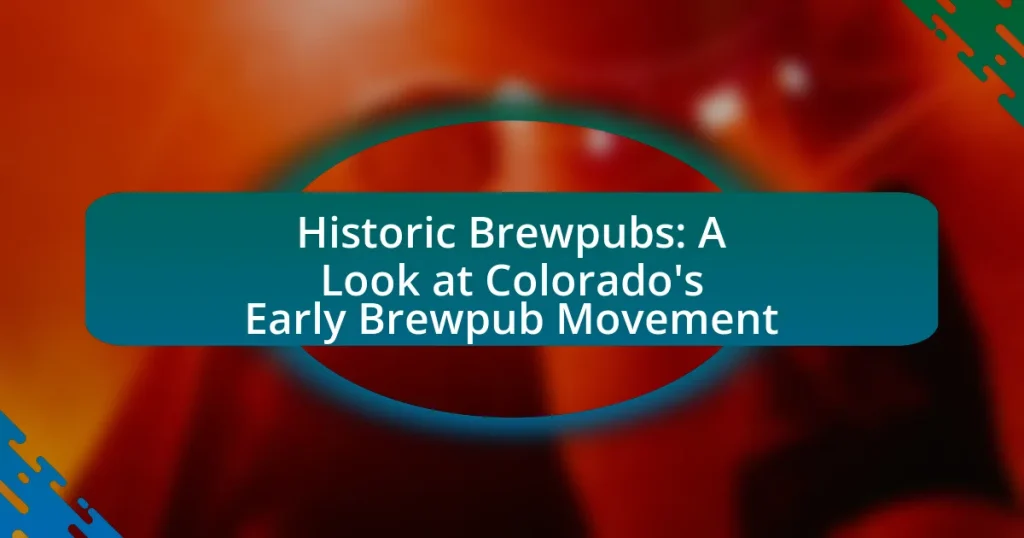Historic brewpubs in Colorado represent a significant aspect of the state’s brewing history, emerging after the legalization of brewpubs in 1988. These establishments combine breweries and pubs, serving house-made beer alongside food, and have played a crucial role in fostering community interaction and supporting the local economy. The article explores the origins of the brewpub movement, key pioneers like Wynkoop Brewing Company, and the challenges faced by early brewpubs, including regulatory hurdles and financial difficulties. It also highlights the impact of these brewpubs on the craft beer industry, their influence on community culture, and the lessons modern brewpubs can learn from their predecessors.

What are Historic Brewpubs and Their Significance in Colorado?
Historic brewpubs in Colorado are establishments that combine a brewery and a pub, serving house-made beer alongside food, and they hold significant cultural and historical value in the state’s brewing landscape. These brewpubs emerged in the late 20th century, particularly after the legalization of brewpubs in Colorado in 1988, which catalyzed the craft beer movement in the region. Their significance lies in their role as community gathering spaces, their contribution to the local economy, and their influence on the craft beer culture, with notable examples like Wynkoop Brewing Company, founded in 1988, which is recognized as one of the first brewpubs in the state.
How did the brewpub movement begin in Colorado?
The brewpub movement in Colorado began in the late 1980s, driven by a combination of changing laws and a growing interest in craft beer. In 1988, Colorado passed legislation allowing the establishment of brewpubs, which enabled breweries to sell their beer on-site alongside food. This legal change catalyzed the opening of several brewpubs, such as Wynkoop Brewing Company, founded in 1988 by John Hickenlooper and others, marking a significant milestone in the state’s brewing history. The success of these early brewpubs fostered a vibrant craft beer culture in Colorado, leading to an explosion of new breweries and brewpubs throughout the 1990s and beyond.
What were the key factors that contributed to the establishment of brewpubs in Colorado?
The key factors that contributed to the establishment of brewpubs in Colorado include legislative changes, a growing craft beer culture, and the state’s unique demographic and geographic characteristics. In 1994, Colorado passed a law allowing brewpubs to sell beer for on-premises consumption, which significantly lowered barriers to entry for entrepreneurs. This legal framework coincided with a burgeoning interest in craft beer, driven by consumers seeking local and diverse beer options. Additionally, Colorado’s outdoor lifestyle and tourism attracted a demographic that favored brewpubs as social gathering spots, further enhancing their popularity and viability in the market.
Who were the pioneers of the brewpub movement in Colorado?
The pioneers of the brewpub movement in Colorado were Charlie Papazian and the owners of the Wynkoop Brewing Company, John Hickenlooper and his partners. Charlie Papazian, a prominent figure in the craft brewing community, helped establish the first brewpub in Colorado, which was the Wynkoop Brewing Company, founded in 1988. This establishment played a crucial role in popularizing the brewpub concept in the state, combining a brewery with a restaurant, and it significantly influenced the craft beer scene in Colorado.
What role did historic brewpubs play in the local culture?
Historic brewpubs served as vital social hubs in local culture, fostering community interaction and cultural exchange. These establishments provided a gathering place for residents, encouraging socialization and the sharing of ideas, which contributed to a sense of belonging and local identity. For example, in Colorado, brewpubs emerged in the 1980s as part of a broader craft beer movement, reflecting regional tastes and preferences while also supporting local agriculture by sourcing ingredients from nearby farms. This connection to local resources reinforced community ties and promoted economic sustainability, illustrating the significant role historic brewpubs played in shaping the cultural landscape.
How did brewpubs influence community gatherings and social interactions?
Brewpubs significantly influenced community gatherings and social interactions by serving as local hubs for socialization and cultural exchange. These establishments provided a relaxed environment where individuals could come together to enjoy craft beer, fostering a sense of community and belonging. Historical data indicates that the rise of brewpubs in Colorado during the early 1980s coincided with a growing interest in local food and drink, which encouraged residents to engage with one another over shared experiences. Additionally, brewpubs often hosted events such as trivia nights, live music, and community fundraisers, further enhancing social interactions and strengthening community ties.
What unique offerings did Colorado’s brewpubs provide compared to traditional bars?
Colorado’s brewpubs offered unique experiences by combining the production of craft beer with a full-service dining experience, distinguishing them from traditional bars. Brewpubs allowed patrons to enjoy freshly brewed beer on-site, often with a diverse selection of house-made brews that reflected local flavors and brewing techniques. Additionally, many brewpubs featured menus that emphasized locally sourced ingredients, creating a farm-to-table dining experience that traditional bars typically did not provide. This integration of brewing and culinary arts fostered a community atmosphere, encouraging social interaction and local engagement, which further set brewpubs apart from conventional drinking establishments.

What Challenges Did Early Brewpubs Face in Colorado?
Early brewpubs in Colorado faced significant challenges, primarily due to restrictive regulations and competition from established breweries. The legal landscape was complicated by Colorado’s stringent liquor laws, which made it difficult for new establishments to obtain the necessary licenses. Additionally, early brewpubs struggled with limited access to distribution channels, as larger breweries dominated the market. These factors hindered their ability to reach customers and establish a loyal patron base, ultimately impacting their sustainability and growth in the competitive brewing industry.
What legal and regulatory hurdles impacted the brewpub movement?
The brewpub movement faced significant legal and regulatory hurdles primarily due to restrictive alcohol laws and licensing requirements. In many states, including Colorado, brewpubs were initially classified under the same regulations as large-scale breweries, which imposed high barriers to entry, such as costly permits and extensive compliance measures. For instance, Colorado’s 1987 law allowed brewpubs to operate but required them to obtain a special license that limited production capacity and mandated food service, complicating operations for new entrants. These regulations were often a result of historical concerns over alcohol consumption and the desire to control distribution, which hindered the growth of the brewpub industry during its formative years.
How did changes in alcohol laws affect the establishment of brewpubs?
Changes in alcohol laws significantly facilitated the establishment of brewpubs by allowing them to operate legally and profitably. In the 1980s, legislative reforms in Colorado, such as the legalization of brewpubs in 1988, enabled these establishments to brew and sell their own beer on-site, which was previously restricted. This legal recognition not only provided a framework for brewpubs to thrive but also contributed to the growth of the craft beer industry in the state, leading to an increase in local breweries and a vibrant beer culture. The changes in laws directly correlated with the rise of brewpubs, as they created opportunities for entrepreneurs to enter the market and cater to consumer demand for locally brewed beer.
What were the financial challenges faced by early brewpub owners?
Early brewpub owners faced significant financial challenges, primarily due to high startup costs and regulatory hurdles. The initial investment required for equipment, ingredients, and facility renovations often exceeded the financial capabilities of many entrepreneurs. Additionally, navigating complex licensing and zoning laws imposed further expenses and delays, complicating the establishment of a profitable business. For instance, in the 1990s, many brewpubs in Colorado struggled with the costs associated with obtaining the necessary permits, which could take months and incur substantial fees. These financial barriers often led to cash flow issues, making it difficult for early brewpubs to sustain operations during their critical initial years.
How did early brewpubs adapt to these challenges?
Early brewpubs adapted to challenges by diversifying their offerings and creating unique experiences for customers. They began to brew a variety of beer styles to attract different consumer preferences, which helped them stand out in a competitive market. Additionally, many brewpubs incorporated food menus that complemented their beer selections, enhancing the overall dining experience. This strategy not only increased customer retention but also encouraged longer visits, leading to higher sales. Historical records indicate that brewpubs in Colorado, such as the Wynkoop Brewing Company established in 1988, successfully implemented these adaptations, contributing to their sustainability and growth during the early brewpub movement.
What innovative strategies did brewpubs employ to survive and thrive?
Brewpubs employed innovative strategies such as diversifying their product offerings, enhancing customer experience, and leveraging local ingredients to survive and thrive. By introducing a variety of craft beers alongside food menus, brewpubs attracted a broader customer base and increased revenue streams. Additionally, creating unique atmospheres and hosting events fostered community engagement and loyalty. Utilizing locally sourced ingredients not only supported local economies but also appealed to consumers’ preferences for fresh and sustainable options. These strategies contributed to the resilience and growth of brewpubs in Colorado’s early brewpub movement, as evidenced by the rise in the number of establishments and their popularity in the region.
How did community support play a role in the success of brewpubs?
Community support was crucial for the success of brewpubs, as it fostered a loyal customer base and encouraged local patronage. In Colorado’s early brewpub movement, community engagement led to increased visibility and word-of-mouth promotion, which were essential for attracting new customers. For instance, brewpubs often hosted local events and collaborated with nearby businesses, creating a sense of community ownership and pride. This local support translated into higher sales and sustainability, as evidenced by the growth of brewpubs in Colorado during the 1990s, where many establishments reported strong community ties as a key factor in their longevity and success.
What Impact Did Colorado’s Early Brewpub Movement Have on the Craft Beer Industry?
Colorado’s early brewpub movement significantly shaped the craft beer industry by pioneering the brewpub model, which combined brewing and dining in a single establishment. This innovation allowed for greater experimentation with beer styles and flavors, fostering a culture of creativity and local sourcing that became foundational to the craft beer ethos. By the mid-1990s, Colorado had over 100 brewpubs, contributing to the state’s reputation as a craft beer hub and influencing national trends in brewing. The success of these brewpubs demonstrated the viability of small-scale, independent breweries, leading to a nationwide craft beer renaissance that emphasized quality, diversity, and community engagement.
How did the early brewpubs influence the growth of craft breweries in Colorado?
Early brewpubs significantly influenced the growth of craft breweries in Colorado by establishing a local culture of craft beer appreciation and providing a model for small-scale brewing operations. The first brewpubs, such as Wynkoop Brewing Company founded in 1988, demonstrated the viability of combining food and craft beer, attracting a dedicated customer base and inspiring entrepreneurs to enter the brewing industry. This led to a rapid increase in the number of craft breweries in Colorado, with the state becoming a leader in craft beer production, boasting over 400 breweries by 2023. The success of these early brewpubs created a supportive community and infrastructure that facilitated the growth of new breweries, fostering innovation and diversity in beer styles.
What trends emerged from the brewpub movement that shaped the craft beer landscape?
The brewpub movement led to several key trends that significantly shaped the craft beer landscape, including the rise of local sourcing, community engagement, and innovative brewing techniques. Local sourcing became prominent as brewpubs emphasized using regional ingredients, which fostered a connection between consumers and local agriculture. Community engagement was enhanced as brewpubs served as social hubs, promoting local culture and events, thereby strengthening community ties. Additionally, innovative brewing techniques emerged as brewpubs experimented with diverse styles and flavors, pushing the boundaries of traditional beer-making. These trends collectively contributed to the growth and diversification of the craft beer industry, establishing a foundation for the modern craft beer culture.
How did the success of brewpubs inspire new breweries across the state?
The success of brewpubs inspired new breweries across the state by demonstrating the viability of craft beer and local brewing. As brewpubs gained popularity, they showcased innovative brewing techniques and unique flavors, attracting a dedicated customer base. This success encouraged aspiring brewers to enter the market, leading to a significant increase in the number of independent breweries. For instance, between 1990 and 2000, Colorado saw a rise from 20 to over 100 breweries, largely influenced by the thriving brewpub model that proved profitable and sustainable.
What lessons can modern brewpubs learn from Colorado’s early brewpubs?
Modern brewpubs can learn the importance of community engagement and quality product from Colorado’s early brewpubs. Early brewpubs in Colorado, such as Wynkoop Brewing Company established in 1988, thrived by fostering strong local connections and offering unique, high-quality beers that reflected local tastes. These establishments often hosted events and collaborated with local businesses, which helped build a loyal customer base. Additionally, the emphasis on brewing innovative and diverse beer styles contributed to their success, as seen in the rise of craft beer popularity during that era. By prioritizing community involvement and product excellence, modern brewpubs can replicate the successful strategies of their predecessors.
What best practices can be derived from the experiences of historic brewpubs?
Best practices derived from the experiences of historic brewpubs include a strong emphasis on community engagement, diverse product offerings, and a focus on quality ingredients. Historic brewpubs often thrived by fostering local relationships, which helped build a loyal customer base and encouraged word-of-mouth marketing. For instance, many early brewpubs in Colorado collaborated with local farmers for fresh ingredients, enhancing the quality of their brews and food offerings. Additionally, offering a variety of beer styles and food pairings catered to diverse customer preferences, which increased patronage and satisfaction. These practices demonstrate that community involvement, quality sourcing, and product diversity are essential for the success of brewpubs.
How can current brewpubs maintain the spirit of community and innovation established by their predecessors?
Current brewpubs can maintain the spirit of community and innovation established by their predecessors by actively engaging with local communities and fostering collaborative brewing practices. This engagement can include hosting community events, supporting local artisans, and sourcing ingredients from nearby farms, which strengthens local ties and promotes a sense of belonging. Historical evidence shows that early Colorado brewpubs thrived by creating spaces for social interaction and innovation, such as the Wynkoop Brewing Company, which not only brewed beer but also served as a cultural hub. By replicating these practices, current brewpubs can honor their legacy while adapting to modern consumer preferences.


